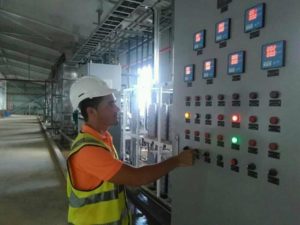 COMPAÑIAS INGLESA Y CHINA INSTALAN EN CUBA LA PRIMERA PLANTA BIOELECTRICA DE LA ISLA.
COMPAÑIAS INGLESA Y CHINA INSTALAN EN CUBA LA PRIMERA PLANTA BIOELECTRICA DE LA ISLA.
La primera planta bioeléctrica de Cuba, que genera electricidad a partir de la biomasa del arbusto de marabú, realiza pruebas tras su sincronización esta semana al Sistema Electroenergético Nacional y se prevé que ahorre unos 100.000 barriles de petróleo anuales cuando entre en funcionamiento.
La nueva planta, ubicada en áreas de una fábrica de azúcar de la provincia de Ciego de Ávila, fue construida con una inversión de 180 millones de dólares que incluye tecnología de una compañía china y la ejecución de las obras a cargo de la empresa mixta BioPower S.A., según informaron medios de prensa cubanos.
Más de mil 500 megawatt entregó al Sistema Eléctrico Nacional (SEN) la primera bioeléctrica de Cuba, durante las pruebas de sincronización realizadas desde el jueves último a las 11 de la noche hasta este domingo a esa hora.
Cuando esté en pleno funcionamiento, se espera que esta unidad genere 60 megavatios de electricidad por día, el equivalente al 50% del consumo energético de Ciego de Ávila, explicó la especialista Carmen Taboada, vicepresidenta de BioPower S.A., con participación cubana, británica y china.
La planta aportará toda la electricidad que necesita el central Ciro Redondo para la producción de azúcar y el resto lo sumará a la red nacional, lo que ahorrará al país unos 100.000 barriles de petróleo al año, dijo la directiva.
Taboada precisó que además de utilizar el marabú, la planta producirá energía limpia durante el período de la zafra azucarera con el empleo del «bagazo», un subproducto de la molienda de la caña.
Los responsables de la obra han señalado que tendrá un impacto en la comunidad porque a partir de su puesta en marcha se eliminará el «bagacillo», un residuo orgánico que se genera en el entorno del ingenio azucarero, y además disminuirá sustancialmente la emisión de dióxido de carbono (CO2) a la atmósfera.
La ejecución de bioeléctricas en Cuba para producir energía limpia mediante biomasa, menos costosa y más eficiente, forma parte de la estrategia que desarrolla el país para cambiar su matriz energética y ampliar el uso de fuentes renovables, hasta llegar al 24% de la generación eléctrica (el 14% provendrá de la biomasa) por estas vías en el año 2030.
 BRITISH AND CHINESE COMPANIES INSTALL IN CUBA THE FIRST BIOELECTRIC PLANT.
BRITISH AND CHINESE COMPANIES INSTALL IN CUBA THE FIRST BIOELECTRIC PLANT.
The first bioelectric plant in Cuba, which generates electricity from the biomass of the marabú bush, tests after its synchronization this week to the National Electroenergetic System and is expected to save about 100,000 barrels of oil annually when it comes into operation.
The new plant, located in areas of a sugar factory in the province of Ciego de Ávila, was built with an investment of 180 million dollars that includes technology from a Chinese company and the execution of works by the joint venture BioPower SA, according to Cuban media reports.
The bioelectric generation tests have been carried out satisfactorily during the last days and have supplied more than 300 megawatts of electricity to the system.
When it is fully operational, this unit is expected to generate 60 megawatts of electricity per day, the equivalent of 50% of the energy consumption of Ciego de Ávila, said specialist Carmen Taboada, vice president of BioPower SA, with Cuban, British and Chinese participation.
The plant will provide all the electricity needed by the Ciro Redondo plant for sugar production and the rest will add it to the national grid, which will save the country about 100,000 barrels of oil per year, the directive said.
Taboada said that in addition to using the marabou, the plant will produce clean energy during the sugar harvest period with the use of «bagasse», a by-product of cane milling.
Those responsible for the work have indicated that it will have an impact on the community because from its start-up the “bagacillo” will be eliminated, an organic waste that is generated in the sugar mill environment and will also substantially reduce the emission of dioxide of carbon (CO2) to the atmosphere.
The execution of bioelectric plants in Cuba to produce clean energy through biomass, less expensive and more efficient, is part of the strategy developed by the country to change its energy matrix and expand the use of renewable sources, up to 24% of electricity generation (14% will come from biomass) by these routes in the year 2030.
Agencies/ EFE/ DDC/ Internet Photos/ Arnoldo Varona/ www.TheCubanHistory.com
THE CUBAN HISTORY, HOLLYWOOD.








